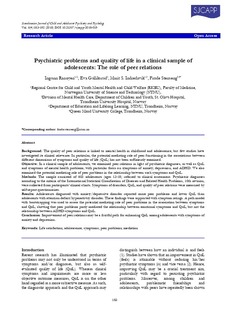| dc.contributor.author | Ranøyen, Ingunn | |
| dc.contributor.author | Gulliksrud, Eva | |
| dc.contributor.author | Indredavik, Marit Sæbø | |
| dc.contributor.author | Stenseng, Frode | |
| dc.date.accessioned | 2019-04-02T13:41:05Z | |
| dc.date.available | 2019-04-02T13:41:05Z | |
| dc.date.created | 2019-01-08T14:29:45Z | |
| dc.date.issued | 2018 | |
| dc.identifier.citation | Scandinavian Journal of Child and Adolescent Psychiatry and Psychology. 2018, 6 (4), 183-192. | nb_NO |
| dc.identifier.issn | 2245-8875 | |
| dc.identifier.uri | http://hdl.handle.net/11250/2592988 | |
| dc.description.abstract | Background: The quality of peer relations is linked to mental health in childhood and adolescence, but few studies have investigated its clinical relevance. In particular, the potential mediating role of peer functioning in the associations between different dimensions of symptoms and quality of life (QoL) has not been sufficiently examined. Objective: In a clinical sample of adolescents, we examined peer relations in light of psychiatric diagnoses, as well as QoL and symptoms of mental health problems, with particular focus on symptoms of anxiety, depression, and ADHD. We also examined the potential mediating role of peer problems in the relationship between such symptoms and QoL. Methods: The sample consisted of 603 adolescents (ages 13-18) referred to clinical assessment. Psychiatric diagnoses according to the criteria of the International Statistical Classification of Diseases and Related Health Problems, 10th revision, were collected from participants’ clinical charts. Symptoms of disorders, QoL, and quality of peer relations were measured by self-report questionnaires. Results: Adolescents diagnosed with anxiety/depressive disorder reported more peer problems and lower QoL than adolescents with attention deficit/hyperactivity disorder. These findings were supported with symptom ratings. A path model with bootstrapping was used to assess the potential mediating role of peer problems in the association between symptoms and QoL, showing that peer problems partly mediated the relationship between emotional symptoms and QoL, but not the relationship between ADHD-symptoms and QoL. Conclusion: Improvement of peer relations may be a fruitful path for enhancing QoL among adolescents with symptoms of anxiety and depression. | nb_NO |
| dc.language.iso | eng | nb_NO |
| dc.publisher | Psychiatric Research Unit, Region Zealand | nb_NO |
| dc.relation.uri | https://www.exeley.com/sj_child_adolescent_psychiatry_psychology/doi/10.21307/sjcapp-2018-019 | |
| dc.rights | Attribution-NonCommercial-NoDerivatives 4.0 Internasjonal | * |
| dc.rights.uri | http://creativecommons.org/licenses/by-nc-nd/4.0/deed.no | * |
| dc.title | Psychiatric Problems and Quality of Life in a Clinical Sample of Adolescents - The Role of Peer Relations | nb_NO |
| dc.type | Journal article | nb_NO |
| dc.type | Peer reviewed | nb_NO |
| dc.description.version | publishedVersion | nb_NO |
| dc.source.pagenumber | 183-192 | nb_NO |
| dc.source.volume | 6 | nb_NO |
| dc.source.journal | Scandinavian Journal of Child and Adolescent Psychiatry and Psychology | nb_NO |
| dc.source.issue | 4 | nb_NO |
| dc.identifier.doi | http://dx.doi.org/10.21307/sjcapp-2018-019 | |
| dc.identifier.cristin | 1652562 | |
| cristin.unitcode | 194,65,35,5 | |
| cristin.unitcode | 194,67,70,0 | |
| cristin.unitname | RKBU Midt-Norge - Regionalt kunnskapssenter for barn og unge - psykisk helse og barnevern | |
| cristin.unitname | Institutt for pedagogikk og livslang læring | |
| cristin.ispublished | true | |
| cristin.fulltext | original | |
| cristin.qualitycode | 1 | |

